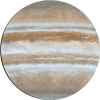Jupiter Observation Details

Jupiter Daily Motion
Jupiter will be visible until June, 25, when it will move too close to the Sun. During this time, its proximity to the Sun will cause it to disappear from the night sky, making it unobservable for a while.
Jupiter Visibility Timetable on December 18
Jupiter Rise and Set Timetable
| Time | Elevation | |
| Moon Rise, 5.8% illuminated | 03:23 | 44° |
| Moon Set | 12:54 | -30° |
| Astrosession begin | 16:25 | -4° |
| Jupiter rise | 16:48 | |
| Jupiter transit | 23:58 | 74° |
| Astrosession end | 03:43 | 39° |
| Civil sunrise | 04:47 | 26° |
| Sunrise | 05:18 | 20° |
| Jupiter set | 07:07 |
Track Jupiter Position Throughout the Night
← Thu, 18 December 2025 →
| Time | |
| Altitude | |
| Azimuth |
Shift the map to change the time and observe Jupiter changing position in the night sky.
Where is Jupiter right now?
Jupiter is located in the constellation Gemini, at right ascension 07h 39m 32s" and declination 21° 40' 33s, approximately 4.31 AU (644,766,823 km) from Earth. At the current time, it is above the horizon at an altitude of 54 degrees toward the west-southwest from your location, with an apparent magnitude of -2.6.Jupiter's Moon Positions
This section offers a comprehensive guide for observing the positions of Jupiter's largest moons—Io, Europa, Ganymede, and Callisto—relative to Jupiter during nighttime. With a telescope, observers can track the rapid movements of these moons as they orbit the gas giant. Io, the closest moon, completes an orbit in just 1.8 days, while Callisto, the farthest of the four, takes about 16.7 days.
Upcoming Events
| Time | Description | Constellation |
|---|---|---|
| Mon, 5 January 2026, 02:02 | Close approach of Jupiter and the Moon. Distance - 3°, position - 44° above the horizon at East | Cancer |
| Sat, 10 January 2026 | Jupiter is in Opposition | Gemini |
| Tue, 10 March 2026 | Retrograde motion of Jupiter ends | Gemini |
| Fri, 27 March 2026, 17:49 | Close approach of Jupiter and the Moon. Distance - 2°, position - 71° above the horizon at Southeast | Cancer |
| Thu, 30 July 2026, 14:00 | Cancer |
Current position of Jupiter in Solar System
| Date | Thu, 18 December 2025 |
| Distance from Earth to Jupiter | 4.3091 AU (644,632,185km) |
| Elongation | 153° |
| Angular diameter | 45.8" |
| Magnitude | -2.6 |
Finder Chart for Jupiter
Double-click to unlock the map.
| Object name | Jupiter |
| Field of view | |
| Limiting magnitude | |
| Jupiter coordinates | 7.65899, 21.67597 |
| Center coordinates | 7.65899, 21.67597 |
Jupiter Passage Through Night
Double-click to unlock the map.
Current position of Jupiter
| Time | 21:28 |
| Latitude | 37.3541 |
| Longitude | -121.955 |
| Jupiter elevation | 54° |
| Jupiter Azimuth | -105° |
Here you can see the current position of the Jupiter on the map, as well as its positions for rise and set. This tool allows you to track the Jupiter's movement throughout the night, providing you with accurate and up-to-date information.
Annual motion of Jupiter
| Date | Fri, 19 December 2025 |
| Twighlight start | 16:25 |
| Twighlight end | 03:41 |
| Twighlight duration | 11h 15m |
| Rise | 16:44 |
| Set | 07:03 |
| Elevation at transit | 74° |
| Transit time | 23:54 |
| Equatorial coordinates | RA: 07h 39m 13s", Dec: 21° 41' 25s |
| Magnitude | -3 |
| Constellation | Gemini |
The graph illustrates the annual visibility pattern of a Jupiter, providing a comprehensive overview of its daily appearances and transit times throughout the year.
The graph is structured with the vertical axis showing the hours of the day, ranging from 12 AM to 12 AM the next day, while the horizontal axis spans each day of the year.
The reddish shaded area indicates the periods when the Jupiter is above the horizon, visible to observers. The white line marks the times when the celestial object reaches its highest point in the sky each day, known as the transit.
The graph is structured with the vertical axis showing the hours of the day, ranging from 12 AM to 12 AM the next day, while the horizontal axis spans each day of the year.
The reddish shaded area indicates the periods when the Jupiter is above the horizon, visible to observers. The white line marks the times when the celestial object reaches its highest point in the sky each day, known as the transit.
Astrometric & Physical Parameters of Jupiter
Coordinates & Visibility
| Right Ascension | 7.65899° |
| Declination | 21.67597° |
| Magnitude | -2.6 |
| Constellation | Gemini |
| Elevation | 54.1° |
| Azimuth | -105.1° |
Basic Properties
| Mass, kg | 1.89819E+27 |
| Mean density, g/cm³ | 1.3262 +- .0003 |
Orbit
| Orbital period, days | 4332.589 d |
Rotation
| Sidereal rotation period, days | 9h 55m 29.711 s |
Surface & Atmosphere
| Surface gravity, m/s² | 28.34 |
| Escape velocity, km/s | 59.5 |
| Mean temperature, K | 165+-5 K |
Brightness
| Visual magnitude V(1,0) | -9.40 |
Data Acknowledgment
Our solar system data—including planetary physical and orbital parameters—comes from the Solar System OpenData API , maintained by Le Système Solaire. We thank Christophe and the contributors for making this open data available.
